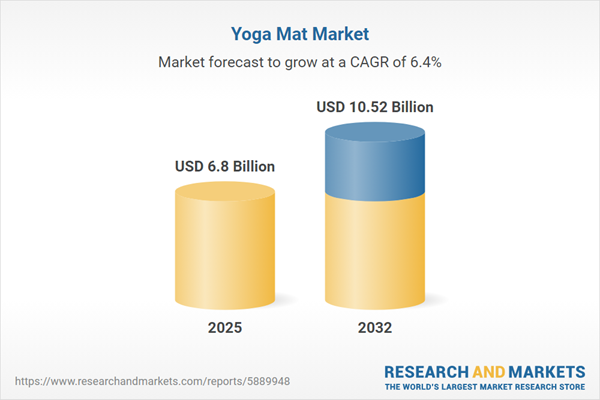Speak directly to the analyst to clarify any post sales queries you may have.
The yoga mat market is experiencing marked transformation as companies align wellness investments with sustainability, technology, and evolving employee needs. Senior leaders are shifting their procurement and supplier strategies to strengthen both workforce health initiatives and compliance readiness.
Market Snapshot: Yoga Mat Market Size and Trajectory
The global yoga mat market is registering sustained growth, supported by a solid compound annual growth rate and diversified revenue streams. High market activity in North America, Asia-Pacific, and Europe highlights the strategic role of yoga mats in workforce wellness integration. Companies are embedding these products within holistic wellness programs, recognizing their importance for retention and improved productivity. As demand increases for quality and cost-effective wellness solutions, suppliers are adapting offerings to address regional standards, further entrenching yoga mats as integral elements within office, educational, and corporate settings. Distribution scalability and versatile procurement structures solidify their relevance across a spectrum of operational environments.
Scope & Segmentation: In-Depth Analysis of the Yoga Mat Market
- Distribution Channels: Enterprises use channels such as specialty retailers, sporting goods outlets, department stores, e-commerce, mass merchandisers, and direct-to-consumer options to ensure procurement matches operational and logistical requirements.
- Thickness Variants: Options range from standard to thick and thin formats, enabling customization for varying ergonomic preferences and adaptation to both high- and low-intensity organizational wellness plans.
- Material Types: Corporate decision-makers evaluate cork, jute, natural rubber, PVC, and TPE yoga mats, weighing each for durability, compliance with industry regulations, and alignment with corporate sustainability objectives.
- Applications: Yoga mats are utilized across settings including fitness studios, at-home corporate wellness, fitness centers, outdoor programs, and formalized wellness initiatives, ensuring flexibility in application and support for remote, in-office, or hybrid staffing needs.
- Regional Analysis: Procurement professionals must navigate region-specific regulations and market drivers across North America, Latin America, Europe, Middle East, Africa, and Asia-Pacific, informing sourcing strategies, risk management, and scalability planning.
- Leading Companies: Prominent industry players such as Manduka LLC, Gaiam, Inc., Jade Yoga, Liforme Ltd., Hugger Mugger Yoga Products, Yoga Design Lab, Decathlon S.A., Aurorae Life LLC, Balance From LLC, and PROSOURCEFIT, Inc., are setting industry benchmarks in innovation, regulatory compliance, and service standards.
Key Takeaways: Strategic Insights for Senior Decision-Makers
- Eco-friendly, ergonomic yoga mats support organizational wellness objectives and advance corporate sustainability commitments by meeting employee and regulatory expectations.
- A broad, omnichannel procurement approach enhances supply chain flexibility, allowing companies to integrate digital and physical purchasing models for improved responsiveness.
- Innovation in materials and design positions businesses to quickly address shifts in compliance and environmental policies while maintaining consistent supply.
- Regional sourcing strategies, including local and nearshoring tactics, can reduce supply risk and reinforce compliance with diverse regulations across jurisdictions.
- Modular, customizable mat options help employers accommodate evolving health and wellness needs, integrating these resources seamlessly into workplace wellness programs.
- Working with wellness experts and embracing direct-to-consumer channels broadens a supplier’s reach, enhancing both market engagement and employee health outcomes at the enterprise level.
Tariff Impact: Navigating Changing Industry Conditions
Tariffs on synthetic polymers and rubber are influencing sourcing and supply strategies across the yoga mat market. In response, organizations are strengthening their supply chains by forging regional partnerships and expanding vertical integration. These initiatives help stabilize procurement, increase operational agility, and secure access to diverse product lines as market requirements and regulatory landscapes evolve.
Methodology & Data Sources
This analysis draws on intensive secondary research, validated through interviews with industry executives, technical specialists, and strategic leaders. Multiple-source corroboration enhances the reliability of these findings for executive and procurement functions.
Why This Report Matters: Actionable Opportunities for Leadership
- Access up-to-date insights on yoga mat product innovation, sustainable sourcing, and wellness strategy optimization to enhance strategic direction and workforce outcomes.
- Strengthen procurement and channel management to achieve a competitive edge in material adoption and align with emerging organizational wellness standards.
- Implement tested recommendations for building supply chain resilience, managing tariff impacts, and maintaining a strong stance on regulatory adherence within long-term wellness initiatives.
Conclusion
The yoga mat market is dynamic, driven by ongoing material innovation, adaptable sourcing strategies, and expanded workplace wellness initiatives. Senior leaders who apply data-driven insights can better position their organizations for compliant, resilient, and effective employee wellness program delivery.
Additional Product Information:
- Purchase of this report includes 1 year online access with quarterly updates.
- This report can be updated on request. Please contact our Customer Experience team using the Ask a Question widget on our website.
Table of Contents
3. Executive Summary
4. Market Overview
7. Cumulative Impact of Artificial Intelligence 2025
Companies Mentioned
The companies profiled in this Yoga Mat market report include:- Manduka LLC
- Gaiam, Inc.
- Jade Yoga, Inc.
- Liforme Ltd.
- Hugger Mugger Yoga Products (QualiTech & Company, Inc.)
- Yoga Design Lab, Inc.
- Decathlon S.A.
- Aurorae Life LLC
- Balance From LLC
- PROSOURCEFIT, Inc.
Table Information
| Report Attribute | Details |
|---|---|
| No. of Pages | 187 |
| Published | October 2025 |
| Forecast Period | 2025 - 2032 |
| Estimated Market Value ( USD | $ 6.8 Billion |
| Forecasted Market Value ( USD | $ 10.52 Billion |
| Compound Annual Growth Rate | 6.4% |
| Regions Covered | Global |
| No. of Companies Mentioned | 11 |









